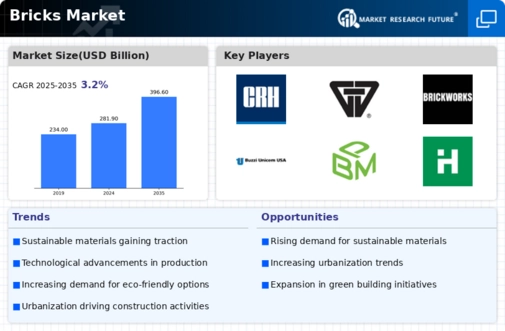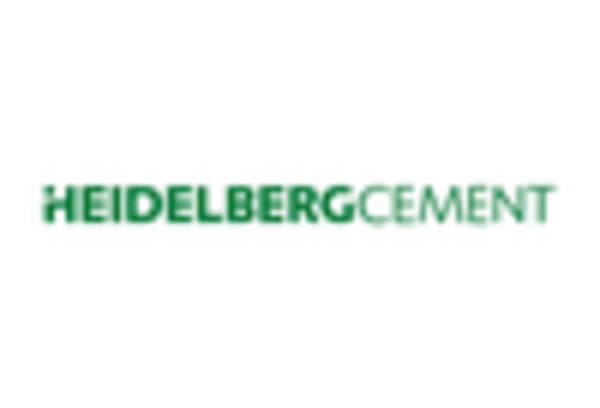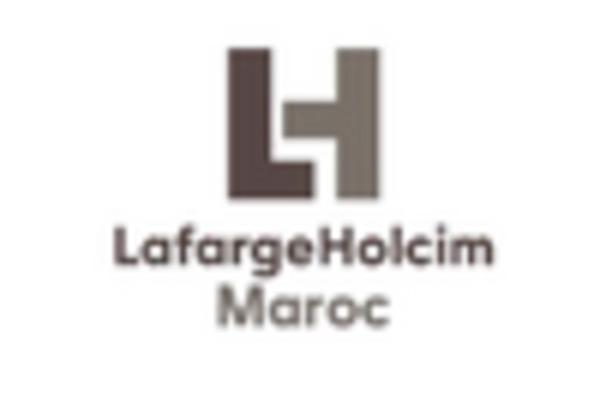Rising Urbanization
Urbanization is a pivotal driver for the Bricks Market, as more individuals migrate to urban areas seeking better opportunities. This trend is leading to a significant increase in residential and commercial construction projects. According to recent statistics, urban areas are expected to house approximately 68 percent of the world's population by 2050. This demographic shift necessitates the construction of new homes, schools, and commercial spaces, all of which rely heavily on bricks. The Bricks Market stands to benefit from this ongoing urban expansion, as the demand for bricks is likely to rise in tandem with the growing population in urban centers. Furthermore, the need for infrastructure to support these urban populations will further enhance the market's growth prospects.
Regulatory Frameworks
Regulatory frameworks play a crucial role in shaping the Bricks Market, as governments implement standards and guidelines for construction materials. Stricter building codes and environmental regulations are prompting manufacturers to innovate and comply with new requirements. For instance, regulations aimed at reducing carbon emissions are encouraging the development of low-carbon bricks. This shift is likely to create opportunities for companies that can adapt to these regulations while maintaining product quality. Furthermore, compliance with safety and environmental standards can enhance a company's reputation, potentially leading to increased market share. As the regulatory landscape continues to evolve, the Bricks Market must remain agile to capitalize on these changes.
Infrastructure Development
The Bricks Market is currently experiencing a surge in demand due to extensive infrastructure development projects. Governments and private sectors are investing heavily in building roads, bridges, and public facilities, which require substantial quantities of bricks. For instance, recent data indicates that the construction sector is projected to grow at a compound annual growth rate of 5.4 percent over the next five years. This growth is likely to drive the demand for bricks, as they are a fundamental building material. Additionally, urbanization trends are contributing to increased construction activities, further bolstering the Bricks Market. As cities expand and new housing projects emerge, the need for durable and sustainable building materials like bricks becomes more pronounced.
Sustainability Initiatives
Sustainability initiatives are increasingly influencing the Bricks Market, as consumers and builders alike prioritize eco-friendly materials. The construction sector is witnessing a shift towards sustainable practices, with a growing emphasis on using materials that minimize environmental impact. Bricks made from recycled materials or those that require less energy to produce are gaining traction. Recent studies suggest that the market for sustainable building materials, including eco-friendly bricks, is expected to grow significantly, potentially reaching a valuation of several billion dollars in the coming years. This trend not only aligns with The Bricks Industry favorably as it adapts to changing consumer preferences and regulatory requirements.
Technological Advancements
Technological advancements are reshaping the Bricks Market, introducing innovative manufacturing processes and materials. Automation and digital technologies are enhancing production efficiency, reducing costs, and improving product quality. For example, the adoption of 3D printing technology in brick manufacturing is emerging as a game-changer, allowing for customized designs and reduced waste. Additionally, advancements in material science are leading to the development of lighter, stronger bricks that meet modern construction demands. As these technologies continue to evolve, they are likely to attract new investments and drive growth within the Bricks Market. The integration of technology not only streamlines production but also enhances the overall sustainability of brick manufacturing.

















Leave a Comment